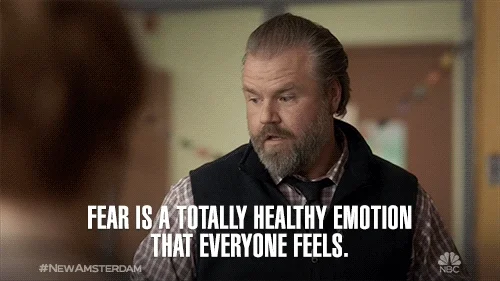Face Your Fears In 3 Simple Steps
Each of us must confront our own fears, must come face to face with them. How we handle our fears will determine where we go with the rest of our lives. To experience adventure or to be limited by the fear of it. ― Judy Blume (Author)
Facing your fear is a crucial success behavior for online entrepreneurs.
Understanding Fear
Symptoms of Fear
Most people don’t even know it’s fear that’s holding them back.
Whenever you postpone a task for later or take a very long time to complete something because you want to do it just right — that procrastination and perfectionism can be a symptom of fear.
And of course, most people who dream of having a business one day don’t even start…
Why We Feel Fear
In order to face our fears, we need to understand what fear is.
Fear is actually nothing bad or something to be crushed and suppressed. It’s in fact a normal physiological response that’s designed to help us.

In the caveman days, we were afraid of predators like tigers and bears. If our ancestors didn’t have those fears, we wouldn’t exist today!
But we don’t actually have to go back that far to find a fear that is normal and healthy, but just not appropriate anymore to the situation.
Let’s say when you were very young or even a short time ago, you had a very unpleasant experience surrounding a situation. Of course, from then on you would try to avoid being in such a situation.
Fear is normal and healthy, though not always appropriate for the situation.
It could also be in the form of judgment from other people. When it comes to creating an online business, many people are paralyzed by the thought of what other people will think of them if they become and entrepreneur.
Three Steps to Facing Your Fears
Step 1: Identify the Fear
The first step to facing your fears is to recognize that you are afraid and admit it to yourself.
Try to identify the fear and its reason as much as possible. What are you afraid of?
A common manifestation of fear is procrastination and it’s the number one reason entrepreneurs fail.
Step 2: Process the Fear
Feel the Fear
Suppressing your emotion is never a good strategy. They will come back even stronger.
You’ve done the first part of identifying your fear. Now it’s time to simply sit with that emotion without distracting yourself.
Just a few meditative minutes, feeling and thinking about the fear can do wonders!
Write about the Fear
Another strategy you can use is to write about your fear.
Especially useful is the free writing technique: You simply write down whatever comes to mind without censorship.
Suppose you have some anxiety about starting an online business. You noticed that you have been thinking about pursuing that dream but haven’t yet made much progress.
You can sit down and write down all the things that come to mind: What if I fail? What will people say? What if I succeed? What if it’s too hard? What if I don’t like it anymore?
Writing down all your doubts and possible answers to those doubts can prove super helpful.
Talk about the Fear with a Trusted Friend

Talking with a friend you trust can get you an outside perspective and will help you reframe the situation.
It may generate some new ideas or even give you a reality check to put the fear into perspective.
If you don’t feel comfortable sharing or would like to try on your own first, you can be your own friend: What would you say if someone brought the topic up with you?
So, to take the example above: What would you tell a person that has anxiety about starting an online business?
Talk to the Fear
Yes, that’s right: Personify the fear and talk to it.
If a person were actively stopping you from fulfilling your dreams, what would you tell them?
You’d probably say something like: Hey, why do you keep doing this to me? What’s your problem, that you can’t let me do this? What do you need me to do to let go?
Even though it might appear crazy or weird, talking to fear — or any emotion for that matter — is a powerful tool of introspection that can help you learn a lot about yourself.
It makes the emotion more concrete and tangible.
Visualize the Fear
What’s the worst that can happen? Seriously, what is it?
When you picture the absolute worst case scenario, and what you would do, it will help you handle any real situation that much more easily.

In order to ground yourself in reality, also picture the scenario where everything goes
perfectly.
In both visualizations, picture in as much detail as possible what you will be doing — how you’ll handle your worst fears with grace and how you’ll absolutely crush it.
Through these visualizations, you also separate the real from the imagined fears.
If you’d like to learn move about processing fear with visualization, the book The Tools: Transform Your Problems into Courage, Confidence, and Creativity by Phil Stutz might help you.
Harness the Fear
Fear can inspire us to action.
Did you know it has the same physiological symptoms as excitement?
By reframing your experience as “I’m excited”, you can turn your fear into energy and motivation
Destroy the Fear with Preparation
We already talked about visualizing the worst case scenarios. Now how about coming up with a plan of how to handle each?
Preparing for the perceived danger will help you deal with it, if it actually manifests, or if anything, it will give you an edge over everyone else.
Become Comfortable with Uncertainty
However, there is a limit to how much you can prepare. There is only so much you can do.
At some point you need to make peace with uncertainty and have confidence in yourself that you can figure things out as they come up.
I highly recommend the book Uncertainty: Turning Fear and Doubt into Fuel for Brilliance to learn more about dealing with uncertainty.
I’ve also written about the book in my article Dealing with Uncertainty: Turning Fear into Fuel (Key Insights from Uncertainty by Jonathan Fields).
A third way to learn from him about this topic is to watch his TED talk.
Fill the Knowledge Gaps
Sometimes we’re afraid simply because we think we lack the required knowledge.
We don’t know what to expect.
Sometimes we don’t even know what we don’t know.
Spending some time doing research can be a great way of dealing with your fears — as long as it doesn’t lead to procrastination.
So spend some times researching, timebox it, and you’ve gained some insights, some knowledge, and know a little bit more of what to expect.
Draw Power from the Past
There was a huge shift in my mindset when I realized one day how worried I had been in the past about various things — and somehow, it just always worked itself out.
When you are faced with an anxiety-provoking challenge, think about situations in your past that you faced and overcame.
Thinking about these past triumphs will give you the confidence you need to move forward.
Trust in yourself, that you can rise to the occasion and find a solution, once again.
You’ve done it before. You can do it again.
Release Control
Some things are just out of our control and it’s important to recognize that.
Make a list of all the things you are worried about. Then divide that list into what you can and what you can’t control.
If you can control something — great! Take action and make a plan to move forward.
And if you can’t control something, then it’s simply time to let it go. That’s also an action: Choose to let go.
Consider the Cost of Keeping the Fear
Don’t underestimate the opportunity cost, the cost of not doing something.
Realizing there is a cost to remaining paralyzed by fear, and that it is much higher than the emotional and mental cost of facing the fear, will hopefully give you that last push you need to take action.
For example, as somebody with entrepreneurial dreams, you can either take action now, work through the things that scare you, do the things you find uncomfortable — or you can realize ten years from now that you are still at the same level of freedom and fulfillment than you are now.
The more you procrastinate on your goals and dreams, the more you will regret later not having started sooner.
You have the choice between the possibility of being uncomfortable vs. the certainty that nothing will change.
Step 3: Take Action (Despite the Fear)
“At the moment of commitment the entire universe conspires to assist you.” – Goethe
The time to take action is now.
Don’t Wait Even 5 Seconds!
According to Mel Robbins, your brain is wired to prevent you from doing things that are scary so
you have about a 5 second window in which you can move from idea to action before your brain kicks into full gear and sabotages any change of behavior.
Take a Bold Step in the Next 20 Minutes
Inaction breeds doubt and fear. Action breeds confidence and courage. If you want to conquer fear, do not sit home and think about it. Go out and get busy. ― Dale Carnegie (Speaker/Writer)
So the next action items for you would be to
- define the next action you need to take to face your fears, and
- take a bold step.
The next action could be the next physical, visible step that can be completed in twenty minutes or less.
This is a concept is taken from Getting Things Done by David Allen.
Create Value by Helping Others
One last tip I’d like to share with you, and that can be very powerful, is to just help someone else.
If you create value and do something that helps someone else solve a pain, worry, problem, fear or desire that they have, then you are pulled away from thinking too much about your own problems.
You get a boost in your confidence and gain momentum. You feel better about yourself and the action you just took will give you the push you needed to take another action of facing your fears.
As a business owner, especially, creating value is exactly what you should do. Everything else is secondary because money will always follow from doing the right thing.
Summary
Thanks for reading! Feel free to reference this article as needed when processing fears.
So whenever you feel anxiety,
- Think of a feat that is stopping you from something you want to do. Identify it.
- Use at least one of the strategies from this article to process the fear.
- Take at least one small next action (or even a big, bold, massive action!) to build momentum and moving you past the fear.
Every time you sense that a fear is holding you back, pull up this article and use it to face your fears.